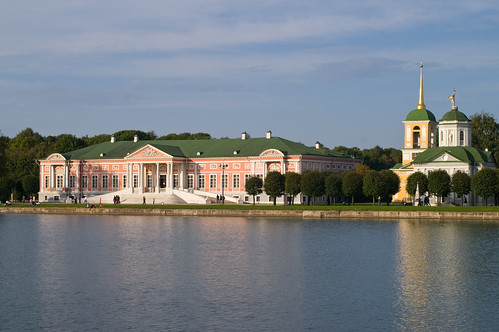Via Flickr:
The Kuskovo Palace * Дворец в Кусково
Kuskovo country house (estate) is located inside Moscow nowdays.
Century ago it was a real country house, located outside Moscow boundaries.
From Wikipedia:
Kuskovo is an extensive estate, or manor, of the Counts Sheremetev originally situated several miles to the east of Moscow but now forming a part of the East District of that city. It is a favourite place of recreation for Muscovites, and one of the few 18th-century suburban residences preserved in the Russian capital.
Kuskovo passed to the Sheremetev family in the 17th century, and was chosen as a summer residence by Boris Petrovich Sheremetev, the premier Russian Field Marshal and Count. The earliest surviving structure is the Saviour church, built in 1737-39 in a Petrine baroque style and formerly decorated with marble statues. The neoclassical bell-tower was added much later, in 1792.
Two curious two-storied structures were erected in Kuskovo during the Elizabethan epoch - the Dutch and Italian houses. They combine elements of the fashionable Rastrelliesque baroque with the ideas of classicism, which started to spread in Europe at that time.
The Kuskovo palace was constructed near one of the ponds in 1769-65 in a fine Neoclassical style. Commissioned by Count Nikolai Petrovich Sheremetev, the structure was apparently designed by a group of his serfs, including Feodor Argunov, Aleksey Mironov, and Grigory Dikushin, although another tradition ascribes it to Charles de Wailly. The palace interiors, as completed in 1779, represent a transitional stage between baroque and neoclassicism. This palace houses the most precious collection of Western porcelain in Eastern Europe, which had been collected by several generations of the Sheremetev family. In 1919 the palace was nationalized, and it was declared the State Museum of Ceramics twenty years later.
Park in Kuskovo.
The French regular park around the palace, with its marble statues and lovely ponds, is probably the only remainder of the baroque gardening in Moscow. Eight park alleys converge in a single point, where the circular Hermitage pavilion (1764-77) still stands. Other structures in the park include the handsome Summer Grotto (1775), the Summer Theatre (1755), the Kitchen wing, a garden parterre, and winter conservatories.
The park and palace were visited by many prominent persons, such as king Stanislaus II of Poland and Empress Catherine the Great. The Sheremetevs marked each visit of the monarch by a marble obelisk or a column, still visible before the palace.
Усадьба Кусково
Усадьба Кусково — архитектурно-художественный ансамбль XVIII в., расположенный на востоке Москвы.
Включает дворец, построенный под руководством архитектора К. И. Бланка во второй половине XVIII века в cтиле классицизма; регулярный, украшенный скульптурой парк с павильонами «Грот», «Оранжерея» (проекты крепостного архитектора Ф.С. Аргунова, вторая половина XVIII в.), «Эрмитаж» (вторая половина XVIII в.), «Итальянский» (XVIII в.) и «Голландский» (XVIII в.) домики.
Усадьба состояла из трёх частей — запрудной со Зверинцем, французского регулярного парка с основным архитектурным ансамблем и английского парка «Гай». С наибольшей полнотой сохранился архитектурно-парковый комплекс центральной парадной части.
Центром ансамбля является Дворец, в котором сохранились планировка и декоративное убранство интерьеров, состоящее из первоклассных произведений русского и западноевропейского изобразительного искусства; уникальная коллекция живописи XVIII века, дарственные портреты русских императоров и нескольких поколений хозяев усадьбы — Шереметевых.
вторник, 18 октября 2011 г.
Kuskovo country house * Усадьба Кусково
Подписаться на:
Комментарии к сообщению (Atom)

Комментариев нет:
Отправить комментарий